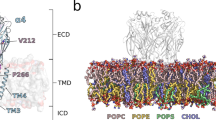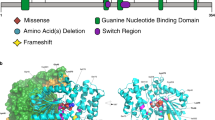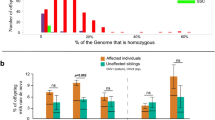Abstract
Maternal 15q11-q13 duplication is the most common copy number variant in autism, accounting for ∼1–3% of cases. The 15q11-q13 region is subject to epigenetic regulation, and genomic copy number losses and gains cause genomic disorders in a parent-of-origin-specific manner. One 15q11-q13 locus encodes the GABAA receptor β3 subunit gene (GABRB3), which has been implicated by several studies in both autism and absence epilepsy, and the co-morbidity of epilepsy in autism is well established. We report that maternal transmission of a GABRB3 signal peptide variant (P11S), previously implicated in childhood absence epilepsy, is associated with autism. An analysis of wild-type and mutant β3 subunit-containing α1β3γ2 or α3β3γ2 GABAA receptors shows reduced whole-cell current and decreased β3 subunit protein on the cell surface due to impaired intracellular β3 subunit processing. We thus provide the first evidence of an association between a specific GABAA receptor defect and autism, direct evidence that this defect causes synaptic dysfunction that is autism relevant and the first maternal risk effect in the 15q11-q13 autism duplication region that is linked to a coding variant.
This is a preview of subscription content, access via your institution
Access options
Subscribe to this journal
Receive 12 print issues and online access
$259.00 per year
only $21.58 per issue
Buy this article
- Purchase on Springer Link
- Instant access to full article PDF
Prices may be subject to local taxes which are calculated during checkout




Similar content being viewed by others
References
Abrahams BS, Geschwind DH . Advances in autism genetics: on the threshold of a new neurobiology. Nat Rev Genet 2008; 9: 341–355.
O'Roak BJ, State MW . Autism genetics: strategies, challenges, and opportunities. Autism Res 2008; 1: 4–17.
Chakrabarti S, Fombonne E . Pervasive developmental disorders in preschool children: confirmation of high prevalence. Am J Psychiatry 2005; 162: 1133–1141.
Jorde LB, Hasstedt SJ, Ritvo ER, Mason-Brothers A, Freeman BJ, Pingree C et al. Complex segregation analysis of autism. Am J Hum Genet 1991; 49: 932–938.
Schanen NC . Epigenetics of autism spectrum disorders. Hum Mol Genet 2006; 15 (Suppl 2): R138–R150.
Sutcliffe J, Nurmi E . Duplication and inherited susceptibility of chromosome 15q11-q13 genes in autism. J Am Acad Child Adolesc Psychiatry 2003; 42: 253–256.
Blatt GJ . GABAergic cerebellar system in autism: a neuropathological and developmental perspective. Int Rev Neurobiol 2005; 71: 167–178.
Blatt GJ, Fitzgerald CM, Guptill JT, Booker AB, Kemper TL, Bauman ML . Density and distribution of hippocampal neurotransmitter receptors in autism: an autoradiographic study. J Autism Dev Disord 2001; 31: 537–543.
Yip J, Soghomonian JJ, Blatt GJ . Decreased GAD67 mRNA levels in cerebellar Purkinje cells in autism: pathophysiological implications. Acta Neuropathol (Berl) 2007; 113: 559–568.
Yip J, Soghomonian JJ, Blatt GJ . Increased GAD67 mRNA expression in cerebellar interneurons in autism: implications for Purkinje cell dysfunction. J Neurosci Res 2008; 86: 525–530.
Dhossche D, Applegate H, Abraham A, Maertens P, Bland L, Bencsath A et al. Elevated plasma gamma-aminobutyric acid (GABA) levels in autistic youngsters: stimulus for a GABA hypothesis of autism. Med Sci Monit 2002; 8: PR1–PR6.
Fatemi SH, Halt AR, Stary JM, Kanodia R, Schulz SC, Realmuto GR . Glutamic acid decarboxylase 65 and 67 kDa proteins are reduced in autistic parietal and cerebellar cortices. Biol Psychiatry 2002; 52: 805–810.
Buxbaum JD, Silverman JM, Smith CJ, Greenberg DA, Kilifarski M, Reichert J et al. Association between a GABRB3 polymorphism and autism. Mol Psychiatry 2002; 7: 311–316.
Cook EH, Courchesne RY, Cox NJ, Lord C, Gonen D, Guter SJ et al. Linkage-disequilibrium mapping of autistic disorder, with 15q11–13 markers. Am J Hum Genet 1998; 62: 1077–1083.
Curran S, Powell J, Neale BM, Dworzynski K, Li T, Murphy D et al. An association analysis of candidate genes on chromosome 15 q11–13 and autism spectrum disorder. Mol Psychiatry 2006; 11: 709–713.
Kim SJ, Brune CW, Kistner EO, Christian SL, Courchesne EH, Cox NJ et al. Transmission disequilibrium testing of the chromosome 15q11-q13 region in autism. Am J Med Genet B Neuropsychiatr Genet 2008; 147B: 1116–1125.
McCauley JL, Olson LM, Delahanty R, Amin T, Nurmi EL, Organ EL et al. A linkage disequilibrium map of the 1-Mb 15q12 GABA(A) receptor subunit cluster and association to autism. Am J Med Genet B Neuropsychiatr Genet 2004; 131: 51–59.
Salmon B, Hallmayer J, Rogers T, Kalaydjieva L, Petersen PB, Nicholas P et al. Absence of linkage and linkage disequilibrium to chromosome 15q11-q13 markers in 139 multiplex families with autism. Am J Med Genet 1999; 88: 551–556.
Maestrini E, Lai C, Marlow A, Matthews N, Wallace S, Bailey A et al. Serotonin transporter (5-HTT) and gamma-aminobutyric acid receptor subunit beta3 (GABRB3) gene polymorphisms are not associated with autism in the IMGSA families. The International Molecular Genetic Study of Autism Consortium. Am J Med Genet 1999; 88: 492–496.
Urak L, Feucht M, Fathi N, Hornik K, Fuchs K . A GABRB3 promoter haplotype associated with childhood absence epilepsy impairs transcriptional activity. Hum Mol Genet 2006; 15: 2533–2541.
Hogart A, Leung KN, Wang NJ, Wu DJ, Driscoll J, Vallero RO et al. Chromosome 15q11–13 duplication syndrome brain reveals epigenetic alterations in gene expression not predicted from copy number. J Med Genet 2008; 16: 691–703.
Hogart A, Nagarajan RP, Patzel KA, Yasui DH, Lasalle JM . 15q11–13 GABAA receptor genes are normally biallelically expressed in brain yet are subject to epigenetic dysregulation in autism-spectrum disorders. Hum Mol Genet 2007; 16: 691–703.
O'Connell JR, Weeks DE . PedCheck: a program for identification of genotype incompatibilities in linkage analysis. Am J Hum Genet 1998; 63: 259–266.
Cordell HJ, Clayton DG . Genetic association studies. Lancet 2005; 366: 1121–1131.
Risi S, Lord C, Gotham K, Corsello C, Chrysler C, Szatmari P et al. Combining information from multiple sources in the diagnosis of autism spectrum disorders. J Am Acad Child Adolesc Psychiatry 2006; 45: 1094–1103.
Purcell S, Neale B, Todd-Brown K, Thomas L, Ferreira MA, Bender D et al. PLINK: a tool set for whole-genome association and population-based linkage analyses. Am J Hum Genet 2007; 81: 559–575.
Kang JQ, Macdonald RL . The GABAA receptor gamma2 subunit R43Q mutation linked to childhood absence epilepsy and febrile seizures causes retention of alpha1beta2gamma2S receptors in the endoplasmic reticulum. J Neurosci 2004; 24: 8672–8677.
Gallagher MJ, Ding L, Maheshwari A, Macdonald RL . The GABAA receptor alpha1 subunit epilepsy mutation A322D inhibits transmembrane helix formation and causes proteasomal degradation. Proc Natl Acad Sci USA 2007; 104: 12999–13004.
Kirkness EF, Fraser CM . A strong promoter element is located between alternative exons of a gene encoding the human gamma-aminobutyric acid-type A receptor beta 3 subunit (GABRB3). J Biol Chem 1993; 268: 4420–4428.
Weinberg CR . Methods for detection of parent-of-origin effects in genetic studies of case-parents triads. A J Hum Genet 1999; 65: 229–235.
Tanaka M, Olsen RW, Medina MT, Schwartz E, Alonso ME, Duron RM et al. Hyperglycosylation and reduced GABA currents of mutated GABRB3 polypeptide in remitting childhood absence epilepsy. Am J Hum Genet 2008; 82: 1249–1261.
Weiss LA, Shen Y, Korn JM, Arking DE, Miller DT, Fossdal R et al. Association between microdeletion and microduplication at 16p11.2 and autism. N Engl J Med 2008; 358: 667–675.
Lord C, Rutter M, Le Couteur A . Autism Diagnostic Interview-Revised: a revised version of a diagnostic interview for caregivers of individuals with possible pervasive developmental disorders. J Autism Dev Disord 1994; 24: 659–685.
Taylor PM, Thomas P, Gorrie GH, Connolly CN, Smart TG, Moss SJ . Identification of amino acid residues within GABA(A) receptor beta subunits that mediate both homomeric and heteromeric receptor expression. J Neurosci 1999; 19: 6360–6371.
McDonald BJ, Amato A, Connolly CN, Benke D, Moss SJ, Smart TG . Adjacent phosphorylation sites on GABAA receptor beta subunits determine regulation by cAMP-dependent protein kinase. Nat Neurosci 1998; 1: 23–28.
Moessner R, Marshall CR, Sutcliffe JS, Skaug J, Pinto D, Vincent J et al. Contribution of SHANK3 mutations to autism spectrum disorder. Am J Hum Genet 2007; 81: 1289–1297.
Szatmari P, Paterson AD, Zwaigenbaum L, Roberts W, Brian J, Liu XQ et al. Mapping autism risk loci using genetic linkage and chromosomal rearrangements. Nat Genet 2007; 39: 319–328.
Marshall CR, Noor A, Vincent JB, Lionel AC, Feuk L, Skaug J et al. Structural variation of chromosomes in autism spectrum disorder. Am J Hum Genet 2008; 82: 477–488.
Feng J, Schroer R, Yan J, Song W, Yang C, Bockholt A et al. High frequency of neurexin 1beta signal peptide structural variants in patients with autism. Neurosci Lett 2006; 409: 10–13.
Yan J, Oliveira G, Coutinho A, Yang C, Feng J, Katz C et al. Analysis of the neuroligin 3 and 4 genes in autism and other neuropsychiatric patients. Mol Psychiatry 2005; 10: 329–332.
Bolton PF, Dennis NR, Browne CE, Thomas NS, Veltman MW, Thompson RJ et al. The phenotypic manifestations of interstitial duplications of proximal 15q with special reference to the autistic spectrum disorders. Am J Med Genet 2001; 105: 675–685.
Laurie DJ, Wisden W, Seeburg PH . The distribution of thirteen GABAA receptor subunit mRNAs in the rat brain. III. Embryonic and postnatal development. J Neurosci 1992; 12: 4151–4172.
Wisden W, Laurie DJ, Monyer H, Seeburg PH . The distribution of 13 GABAA receptor subunit mRNAs in the rat brain. I. Telencephalon, diencephalon, mesencephalon. J Neurosci 1992; 12: 1040–1062.
Ma W, Saunders PA, Somogyi R, Poulter MO, Barker JL . Ontogeny of GABAA receptor subunit mRNAs in rat spinal cord and dorsal root ganglia. J Comp Neurol 1993; 338: 337–359.
Homanics GE, DeLorey TM, Firestone LL, Quinlan JJ, Handforth A, Harrison NL et al. Mice devoid of gamma-aminobutyrate type A receptor beta3 subunit have epilepsy, cleft palate, and hypersensitive behavior. Proc Natl Acad Sci USA 1997; 94: 4143–4148.
Krasowski MD, Rick CE, Harrison NL, Firestone LL, Homanics GE . A deficit of functional GABA(A) receptors in neurons of beta 3 subunit knockout mice. Neurosci Lett 1998; 240: 81–84.
DeLorey TM, Sahbaie P, Hashemi E, Homanics GE, Clark JD . Gabrb3 gene deficient mice exhibit impaired social and exploratory behaviors, deficits in non-selective attention and hypoplasia of cerebellar vermal lobules: a potential model of autism spectrum disorder. Behav Brain Res 2008; 187: 207–220.
DeLorey TM . GABRB3 gene deficient mice: a potential model of autism spectrum disorder. Int Rev Neurobiol 2005; 71: 359–382.
Sutcliffe JS, Nurmi EL, Lombroso PJ . Genetics of childhood disorders: XLVII. Autism, part 6: duplication and inherited susceptibility of chromosome 15q11-q13 genes in autism. J Am Acad Child Adolesc Psychiatry 2003; 42: 253–256.
Meguro M, Mitsuya K, Sui H, Shigenami K, Kugoh H, Nakao M et al. Evidence for uniparental, paternal expression of the human GABAA receptor subunit genes, using microcell-mediated chromosome transfer. Hum Mol Genet 1997; 6: 2127–2133.
Samaco RC, Hogart A, Lasalle JM . Epigenetic overlap in autism-spectrum neurodevelopmental disorders: MECP2 deficiency causes reduced expression of UBE3A and GABRB3. Hum Mol Genet 2005; 14: 483–492.
Weiss LA, Gonen D, Kim SJ, Yang Z, Cox NJ, Cook EH . Association of variation between GABRB3 exon 3 and 155CA-2 with Autistic Disorder. Am J Hum Genet 2002; 71: A448.
Tsuboi T, Endo S . Incidence of seizures and EEG abnormalities among offspring of epileptic patients. Hum Genet 1977; 36: 173–189.
Ottman R, Annegers JF, Hauser WA, Kurland LT . Higher risk of seizures in offspring of mothers than of fathers with epilepsy. Am J Hum Genet 1988; 43: 257–264.
Cook Jr EH, Lindgren V, Leventhal BL, Courchesne R, Lincoln A, Shulman C et al. Autism or atypical autism in maternally but not paternally derived proximal 15q duplication. Am J Hum Genet 1997; 60: 928–934.
Schanen NC . Epigenetics of autism spectrum disorders. Hum Mol Genet 2006; 15 (Spec No 2): R138–R150.
Nakatani J, Tamada K, Hatanaka F, Ise S, Ohta H, Inoue K et al. Abnormal behavior in a chromosome-engineered mouse model for human 15q11–13 duplication seen in autism. Cell 2009; 137: 1235–1246.
Bunzel R, Blumcke I, Cichon S, Normann S, Schramm J, Propping P et al. Polymorphic imprinting of the serotonin-2A (5-HT2A) receptor gene in human adult brain. Brain Res Mol Brain Res 1998; 59: 90–92.
Loiseau P, Duche B, Pedespan JM . Absence epilepsies. Epilepsia 1995; 36: 1182–1186.
Tuchman R, Rapin I . Epilepsy in autism. Lancet Neurol 2002; 1: 352–358.
Levisohn PM . The autism-epilepsy connection. Epilepsia 2007; 48 (Suppl 9): 33–35.
Sutcliffe JS, Delahanty RJ, Prasad HC, McCauley JL, Han Q, Jiang L et al. Allelic heterogeneity at the serotonin transporter locus (SLC6A4) confers susceptibility to autism and rigid-compulsive behaviors. Am J Hum Genet 2005; 77: 265–279.
Nejentsev S, Walker N, Riches D, Egholm M, Todd JA . Rare variants of IFIH1, a gene implicated in antiviral responses, protect against type 1 diabetes. Science 2009; 324: 387–389.
Acknowledgements
We thank all the families who participated in this research. We thank Wang Zhen Shen and Ningning Hu for their excellent technical assistance. This work was supported by National Institutes of Health Grants MH061009 and NS049261 to JSS, NS33300 and NS51590 to RLM, P50 HD055751 to EHC, P50 MH081755 to EC and a CURE research grant to JQK.
Author information
Authors and Affiliations
Corresponding author
Ethics declarations
Competing interests
The authors declare no conflict of interest.
Additional information
Supplementary Information accompanies the paper on the Molecular Psychiatry website
Supplementary information
Rights and permissions
About this article
Cite this article
Delahanty, R., Kang, J., Brune, C. et al. Maternal transmission of a rare GABRB3 signal peptide variant is associated with autism. Mol Psychiatry 16, 86–96 (2011). https://doi.org/10.1038/mp.2009.118
Received:
Revised:
Accepted:
Published:
Issue Date:
DOI: https://doi.org/10.1038/mp.2009.118
Keywords
This article is cited by
-
Epigenomic signatures reveal mechanistic clues and predictive markers for autism spectrum disorder
Molecular Psychiatry (2023)
-
Generational synaptic functions of GABAA receptor β3 subunit deteriorations in an animal model of social deficit
Journal of Biomedical Science (2022)
-
A systematic review of common genetic variation and biological pathways in autism spectrum disorder
BMC Neuroscience (2021)
-
Endoplasmic reticulum retention and degradation of a mutation in SLC6A1 associated with epilepsy and autism
Molecular Brain (2020)
-
Epigenetics and cerebral organoids: promising directions in autism spectrum disorders
Translational Psychiatry (2018)



